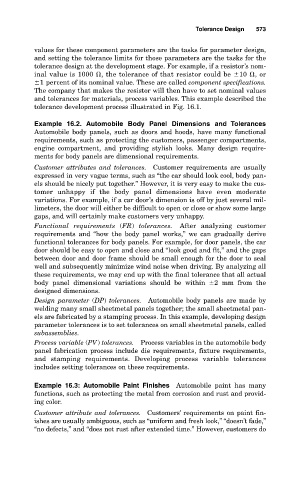Page 620 - Design for Six Sigma a Roadmap for Product Development
P. 620
Tolerance Design 573
values for these component parameters are the tasks for parameter design,
and setting the tolerance limits for those parameters are the tasks for the
tolerance design at the development stage. For example, if a resistor’s nom-
inal value is 1000 , the tolerance of that resistor could be 10 , or
1 percent of its nominal value. These are called component specifications.
The company that makes the resistor will then have to set nominal values
and tolerances for materials, process variables. This example described the
tolerance development process illustrated in Fig. 16.1.
Example 16.2. Automobile Body Panel Dimensions and Tolerances
Automobile body panels, such as doors and hoods, have many functional
requirements, such as protecting the customers, passenger compartments,
engine compartment, and providing stylish looks. Many design require-
ments for body panels are dimensional requirements.
Customer attributes and tolerances. Customer requirements are usually
expressed in very vague terms, such as “the car should look cool, body pan-
els should be nicely put together.” However, it is very easy to make the cus-
tomer unhappy if the body panel dimensions have even moderate
variations. For example, if a car door’s dimension is off by just several mil-
limeters, the door will either be difficult to open or close or show some large
gaps, and will certainly make customers very unhappy.
Functional requirements (FR) tolerances. After analyzing customer
requirements and “how the body panel works,” we can gradually derive
functional tolerances for body panels. For example, for door panels, the car
door should be easy to open and close and “look good and fit,” and the gaps
between door and door frame should be small enough for the door to seal
well and subsequently minimize wind noise when driving. By analyzing all
these requirements, we may end up with the final tolerance that all actual
body panel dimensional variations should be within 2 mm from the
designed dimensions.
Design parameter (DP) tolerances. Automobile body panels are made by
welding many small sheetmetal panels together; the small sheetmetal pan-
els are fabricated by a stamping process. In this example, developing design
parameter tolerances is to set tolerances on small sheetmetal panels, called
subassemblies.
Process variable (PV) tolerances. Process variables in the automobile body
panel fabrication process include die requirements, fixture requirements,
and stamping requirements. Developing process variable tolerances
includes setting tolerances on these requirements.
Example 16.3: Automobile Paint Finishes Automobile paint has many
functions, such as protecting the metal from corrosion and rust and provid-
ing color.
Customer attribute and tolerances. Customers’ requirements on paint fin-
ishes are usually ambiguous, such as “uniform and fresh look,” “doesn’t fade,”
“no defects,” and “does not rust after extended time.” However, customers do

